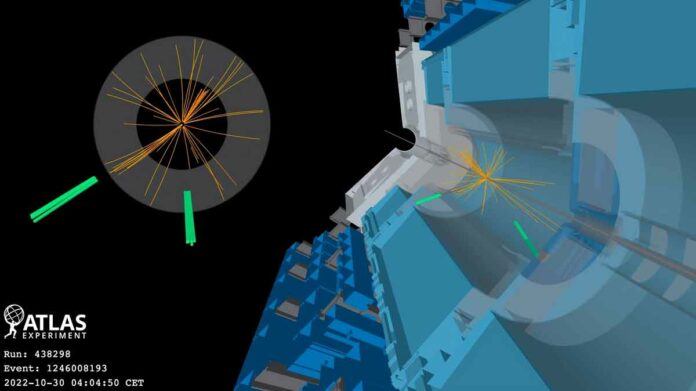The Higgs boson, a key particle in understanding the fundamental structure of the universe, continues to be at the forefront of scientific research since its discovery 11 years ago at the Large Hadron Collider (LHC).
Physicists rely on precise measurements of the Higgs boson’s properties to test the validity of the Standard Model, our best theory describing the world of particles and their interactions.
This week, at the Lepton Photon Conference, the ATLAS collaboration announced a groundbreaking achievement – they have measured the mass of the Higgs boson with unparalleled precision.
The mass of the Higgs boson is not predicted by the Standard Model, making experimental measurement essential.
This value determines the strength of interactions between the Higgs boson and other elementary particles, as well as within itself.
Having an accurate measurement of this fundamental parameter is crucial for theoretical calculations, allowing physicists to compare their findings with predictions from the Standard Model.
Any deviations from these predictions could indicate the existence of new and unexplained phenomena, adding to our understanding of the universe’s mysteries.
Additionally, the Higgs boson’s mass plays a vital role in the evolution and stability of the vacuum in the universe.
Over the years since its discovery, the ATLAS and CMS collaborations have been striving to obtain increasingly precise measurements of the Higgs boson’s mass.
The latest ATLAS measurement combines two results: one based on the particle’s decay into two high-energy photons (the “diphoton channel”) and another from its decay into four leptons (the “four-lepton channel”).
The new measurement in the diphoton channel is particularly remarkable.
It combines analyses of the entire ATLAS data from both Runs 1 and 2 of the LHC, resulting in a mass of 125.22 billion electronvolts (GeV) with an astonishing uncertainty of only 0.14 GeV.
This represents a precision of 0.11%, making it the most precise measurement of the Higgs boson’s mass from a single decay channel to date.
The significant improvement in precision can be attributed to two key factors. Firstly, the full ATLAS Run 2 data set has dramatically reduced the statistical uncertainty by a factor of two.
Secondly, the calibration of photon energy measurements has undergone substantial improvements, reducing the systematic uncertainty by nearly a factor of four to an impressive 0.09 GeV.
Stefano Manzoni, convener of the ATLAS electron-photon calibration subgroup, emphasized the critical role played by advanced and rigorous calibration techniques.
He stated, "Their development took several years and required a deep understanding of the ATLAS detector. They will also greatly benefit future analyses."
Combining the new diphoton channel measurement with the earlier four-lepton channel measurement, the researchers determined the Higgs boson’s mass to be 125.11 GeV with an uncertainty of 0.11 GeV.
This is currently the most precise measurement of this crucial parameter, boasting a precision of 0.09%.
ATLAS spokesperson Andreas Hoecker applauded the collaboration’s relentless dedication to data improvement.
He explained, "Powerful reconstruction algorithms paired with precise calibrations are the determining ingredients of precision measurements. The new measurement of the Higgs boson's mass adds to the increasingly detailed mapping of this critical new sector of particle physics."
The latest achievement by the ATLAS collaboration not only furthers our understanding of the Higgs boson but also pushes the boundaries of scientific knowledge in the realm of particle physics.
The quest to unlock the secrets of the universe continues, with researchers building on this milestone to explore even deeper into the mysteries of the cosmos.
FAQs
The Higgs boson is a fundamental particle that plays a crucial role in understanding the structure of the universe. Its mass is a fundamental parameter that governs the strength of interactions between the Higgs boson and other elementary particles. It also affects the particle’s interactions with itself. Precisely measuring the Higgs boson’s mass is essential for testing the validity of the Standard Model, our current best theory describing particle physics.
The mass of the Higgs boson is not predicted by the Standard Model; hence, it must be determined through experimental measurement. Physicists use advanced techniques and analyses of particle decay channels to derive its mass value. The ATLAS collaboration at the Large Hadron Collider (LHC) has been conducting precise measurements to determine the Higgs boson’s mass.
Precise measurements of the Higgs boson’s mass allow physicists to compare experimental results with theoretical predictions from the Standard Model. Any deviations from these predictions could indicate the existence of new or unexplained phenomena in particle physics. Thus, achieving high precision in mass measurements contributes to our understanding of the fundamental forces and particles that shape the universe.
The latest achievement by the ATLAS collaboration was the measurement of the Higgs boson’s mass in the diphoton channel with unparalleled precision. By combining analyses of data from both Runs 1 and 2 of the LHC, they obtained a mass of 125.22 billion electronvolts (GeV) with an uncertainty of only 0.14 GeV. This represents a precision of 0.11%, making it the most precise measurement to date from a single decay channel.
The improved precision in the diphoton channel measurement was achieved through two key factors. First, the use of the full ATLAS Run 2 data set significantly reduced the statistical uncertainty by a factor of two. Second, the calibration of photon energy measurements underwent significant enhancements, decreasing the systematic uncertainty by nearly a factor of four to an impressive 0.09 GeV.
The Higgs boson’s mass is a crucial parameter that influences the evolution and stability of the vacuum in the universe. Understanding the properties of the Higgs boson allows physicists to gain insights into the nature of the vacuum and its role in the cosmos. By studying the Higgs boson’s mass, researchers can better comprehend the fundamental forces that govern the universe’s behavior on both a micro and macro scale.

